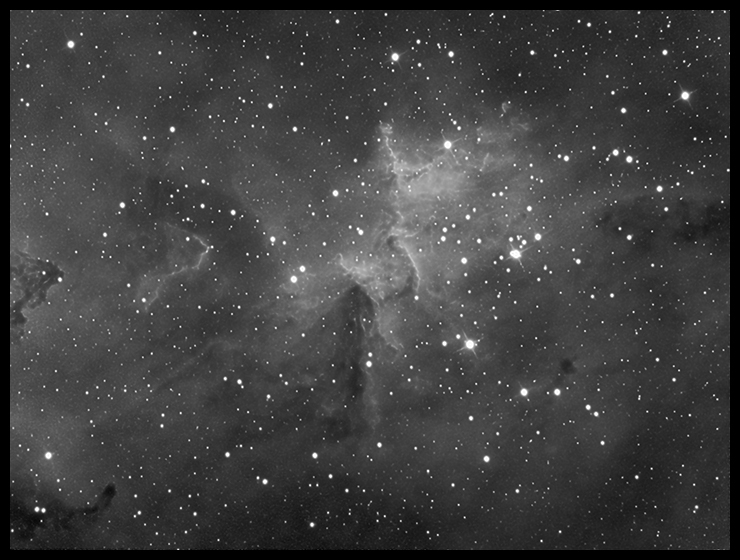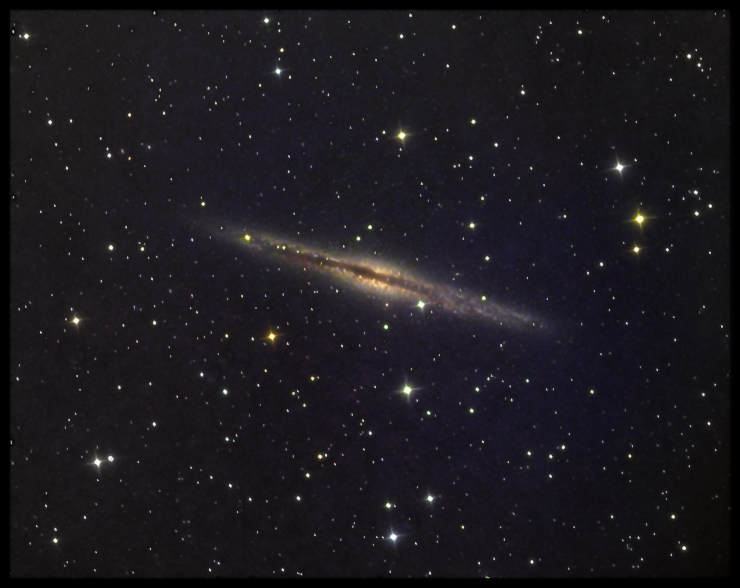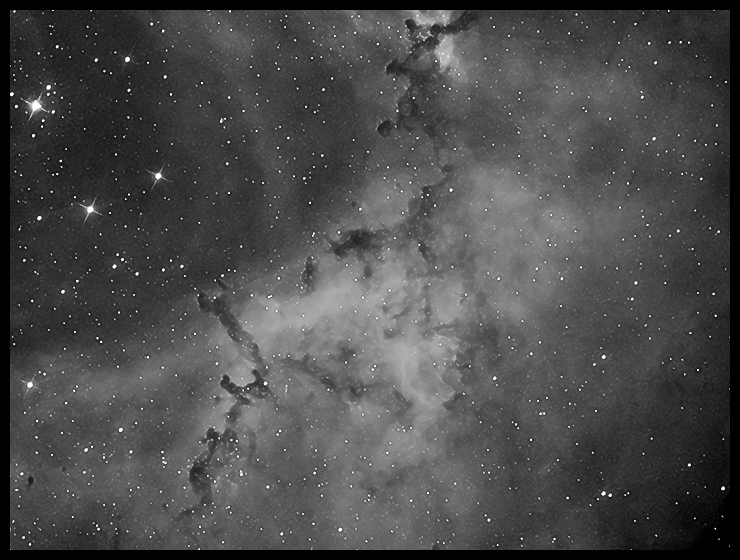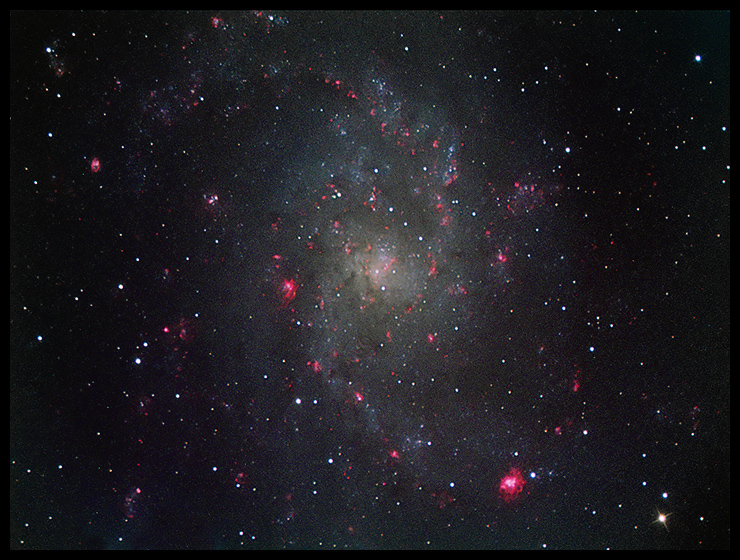01/06/2014. Shot through the Heart! Tonight is clear and cold with atrocious seeing. Guiding is spot on, focus verified, but stars are blobs. I wanted to try the central region of IC 1805, the Heart Nebula, where several bright stars mingle with bright and dark nebulae.
The temperature at sunset was just under 30°F, but it was 12°F just a few hours later (the overnight low was 5°F). The Peltier cooler on the CCD ran at only 8-11% to hold the chip at -20°C (-4°F).
An astronomical met site said I should expect poor, 2.5 arc-second seeing, but I think it was worse than that (Datil Well, NM, has 0.4 arc second seeing tonight and is 15 degrees warmer despite being 7,800 feet above sea level — just sayin'). I was so discouraged by the first four captures that I discarded the associated color data and reframed the subject to start over. I didn't expect sharper results, but I thought I might as well look for a better composition. Well.
Tonight's lesson is this: trust your deconvolution software. After PixInsight stretched and sharpened the first four images, the result was decent. Encouraging. After one frame at the new orientation, I decided that I liked the second framing even less than the first, so I tried again and asked for six, 1800 second exposures.
The third composition worked well enough. On a lark I asked Maxim to stack all tonight's H-a data despite the three different orientations. That's four images from the first try, one from the second, and six from the third, for a total of 5.5 hours of exposure. I aligned them all on the last composition, and the mix is not bad:

IC 1805
11x1800s (5.5 hours) H-a
At the last minute, with the field slanting into the trees, I decided to at least wave at taking color data. I asked for 5 minutes in each RGB channel. red and green came down smoothly, but my first attempt at blue trailed badly for unknown reasons. While standing outside, I set up a second try and waited for it to complete. At 2 AM, I closed up for the night despite the clear sky overhead. I just didn't want to stand around lining up a new image. By then, the temperature was 7°F. The air was completely still, thank goodness. Here's the night's data pile:

IC 1805
11x1800s (5.5 hours) H-a
1x300s (15 minutes total) RGB
I recalibrated the mount so that a slew back to IC 1805 will let me pick up quickly tomorrow evening. I want a good bit more color, and more H-a never hurts. I'll aim a little to the left to pick up more of those intricate dark nebula along the edge of the field. We'll see what the sky has in mind.
01/07/2014. I tried to add exposure to the subject tonight but discovered the telescope mount had shifted enough to defeat its best efforts at fine guiding. I'm guessing frost heaves or some similar microtectonics related to the cold moved one of the mount's supports. I got a hint that all was not well when I resumed from park and asked the mount to slew to Deneb for a focus check. It missed. I'm seeing greatly degraded precision (corrections of 1-2 pixels every 15 seconds; RMS is over 1 pixel in both axes with too-frequent excursions of 3-5 pixels). I cut the guiding interval way down to try to keep on top of it, but guiding on 11th magnitude stars through a narrowband filter really needs longer integrations than the five second exposures the poor alignment allows. It's not hard to realign with the right-angle finder and its novel reticle except when frostbite gets in the way (it's 9°F). I may give it a try here in a minute, but if I run into any issues at all I'll wait for the next clear (and warmer) evening.
Adjusted. Recalibrated on Capella. Slewed to the Rosette. Running a LRGBHa sequence until it hits the horizon... DAMN it's cold out there!
Now that I've warmed up a bit, let me explain: I attached the A-P "RAPAS" to the mount and found Polaris at least a third of the field too high and slightly to one side of its proper place. That's a shift of about a degree. Presumably the northern support for the mount has been heaved up by frozen ground. After adjusting the polar alignment, I slewed to Capella. The star did not appear on the chip, but I came inside and found the star by taking long exposures and then following its long diffraction spikes. I centered Capella, went back outside, recalibrated the A-P electronics, and then slewed to NGC 2246 which landed dead center on the CCD (yay! a good sign). Back indoors, I recalibrated the guider, tweaked the composition, and then started a long sequence of L, R, G, B, and H-a exposures. I watched for a while as the guider applied only the sub-arcsecond guide corrections to which I have grown accustomed (0.2 - 0.5 pixels every 10 seconds), then hit the sack leaving the telescope to do its thing.

NGC 2246
3 x 1800s H-a (used as luminance), 1.5 hours
3 x 300 RGB (45 minutes total)
Tracking was fine throughout the series of exposures, but something produced huge PSF's toward the end of the session. I suspect frost on the optics. I discarded almost as much data as I used in the photo above. The added data for IC 1805 worked well enough despite the tracking issues, but combining all available frames adds little to yesterday's effort — let's save some bandwidth.
01/08/2014. I refined the polar alignment in deep twilight and took aim at NGC 891 to test it. I'd repointed the polar axis by about 15 arc minutes, but I didn't see much (any?) improvement over last night's hasty effort. Either the alignment is actually still off by about the same amount or those last dozen arc minutes don't matter much with a good guider. Eventually, I'll spend some time redoing a proper drift alignment and reset the RAPAS's mounting hardware. In the meantime, this degree of alignment will serve nicely. Here's the test image (it's not among my best of this subject which are many hours long; this one is an engineering trial):

NGC 891
31x300s L (2h 35m), 4x300s RGB (1h)
Guiding: ~0.5 pixels RMS in both axes w/10s integrations
01/12/2014. After the thaw, I had to reset the polar alignment. This time it's better. RMS on the order of 0.35 pixels for 20 second integrations. I addded more exposure to IC 1805 and finally managed to include more of those dark forms to the left. Then finished the night on NGC 2237, that portion of the Rosette dominated by intricate dark lace, but tracking went askew during the fourth integration (clouds?) and never recovered before the field set. Tonight's CCD orientation is 25 degrees; the chip temperature is still -20°C. I tightened the shaft coupler to re-enable Robofocus on the AT10RC; it worked well. The simple two-button in/out remote pad may have flaked out; the rest of the Robofocus system seems solid.
The Moon was too bright and too close to NGC 2237 to take any but narrowband data. RGB soon. Some OIII in this field (in these fields) would be nice also.

IC 1805
26x1800s (13 hours) H-a
1x300s (15 minutes total) RGB

NGC 2237
3x1800s (1.5 hours) H-a
Just a good start.
01/14/2014. H-a of M33 and IC 342. Pretty dismal results for both. I think the filter is cutting through the moonlight just fine, but the haze is costly. A fresh flat may make a difference. (Amen! A good flat made all the difference.) The best I've got is not gorgeous, but it's not hopeless either. It's shown small, so you know I'm not thrilled with it:

M33
5x1800s (2h30m) H-a used as R
3x300s B, 2x300s G (25m total)
Mostly, I just wanted to image something despite the full Moon and I wanted to work out some routines to substitute H-a data for the R channel to emphasize star-forming regions in our own and in other galaxies. So far, so good. On a clear night, we'll do better. I swung around to add data to the NGC 2237 image above, but the Moon was parked about twelve degrees away. I tried some short exposures, but that's just too close.
Two hardware problems, apparently unrelated: Robofocus won't respond. And the 12V DC power supply to the CCD appears to be dead. That's not good. I dug out the AC brick for the CCD and plugged it in by depriving the computer of its heating pad. I don't know what to make of the RoboFocus issue. It's happened before; I'll recheck all the connections by daylight. Astronomics advertised a DC power supply for the SBIG. Those are discontinued and getting scarce. It's now or never, I thought, and bit the bullet. The new one will be a replacement, a spare, or an important bit of the RV-kit: it's useful one way or another. I read somewhere that SBIG made these by modifying a stock-standard item to output both 12 and 5 volts through one DIN plug. Should I be thinking about using two different voltage regulators to feed the appropriate leads, splicing the wires into one cable? Or doing the same mod here? Maybe, but not yet. Not if this order gets filled.
1/16/2014. More (bad) data for M33. Move along, move along. Nothing to see here.
1/17/2014. There are two 12vdc outputs on the Pyramid PS-15KX 10A power supply tucked into the big Pelican case that holds all the data and power distribution connections. The binding posts connection is dead and that is the one that powered the RigRunner and through it the CCD, COM ports, USB hub, and RoboFocus. The cigarette lighter connection powers the mount and it works fine. The CCD did not work at all. Robofocus and items that preferred additional power through USB lines sometimes, but not always, worked.
I rewired the distribution case to take power only from the cigarette lighter adapter, and I suffered an epiphany about how the RigRunner's Anderson PowerPole connectors, uhm, connect. Clips hold the mated connectors together and keep what's plugged in from coming unplugged; the connections do not snap together or just stay together via friction, compression, or whatever. I've been getting away with not using those clips all this time. So, I addressed a host of issues this morning. I've only tested parts of the system but each seems solid. I'm not going to invite moisture into the camera by trying it out before I want to use it, but I know it can be run from the AC adapter, and I no longer have any reason to think its proprietary 12v DC adapter is dead. We'll find out for sure tonight or tomorrow. The second SBIG 12vdc power adapter will become a spare for now and an RV-kit component by and by. As for those posts... I only see one fuse on the back of the power supply. The only liability I see is that if one output can fail, so, presumably, can the other. If that happens, I have a smaller power supply I can use, or I can drive everything straight from a 12v battery. All in all, I'd rather find the problem and keep both outputs working.
Except where noted, deep-sky photos are made with an SBIG ST2000XM CCD behind a 10-inch Astro-Tech Ritchey-Chretien carried on an Astro-Physics Mach1GTO. The CCD is equipped with Baader LRGB and 7nm H-a filters. The internal guide chip of the CCD most often keeps the OTA pointed in the right direction (I'll let you know when a Meade DSI and a separate OAG or guidescope takes its place). Camera control and guiding are handled by Maxim DL 5.12. The stock focuser on the AT10RC has been augmented with Robofocus 3.0.9 using adapters turned on the lathe downstairs. Maxim performs image calibration, alignment, and stacking; Photoshop CS4 and FocusMagic 3.0.2 take it from there. Gradient Xterminator by Russell Croman and Astronomy Tools by Noel Carboni see their share of work, too. Beginning in May 2013, PixInsight has taken over some of the heavy lifting for transfer function modification and deconvolution.
:: top ::